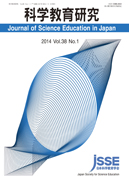
- 1 号 p. 1-
- |<
- <
- 1
- >
- >|
-
清水 美憲2024 年 48 巻 1 号 p. 1-
発行日: 2024年
公開日: 2024/04/09
ジャーナル フリーPDF形式でダウンロード (506K)
-
北田 健, 鎌田 正裕2024 年 48 巻 1 号 p. 3-11
発行日: 2024年
公開日: 2024/04/09
ジャーナル フリーIn many experiments for students using the Daniell cell, it is easy for the students to observe that the anode (Zn) turns black within one school hour as the cell is discharged. However, it is not easy for them to recognize the dissolution of the anode, or the phenomenon that the zinc metal changes into ions in the anode reaction. In this study, we first clarified that the formation of black substance on the anode is not caused by the electrode reaction, and developed a new teaching material “metal foil Daniell battery” that clearly showed the change of the electrode within 30 minutes. Then, after giving a lesson using this material to students in the third year of junior high school, a free-description questionnaire was conducted. 73.3% of the students who used this material mentioned a change in the shape of the anode (Zn). Only 11.1% of students who used previous materials mentioned shape changes, and 70.4% only described color changes. Thus, it was made clear that the teaching material developed in this study helped students understand the anode reaction based on their own observation.
抄録全体を表示PDF形式でダウンロード (6497K) -
福嶋 卓海2024 年 48 巻 1 号 p. 12-23
発行日: 2024年
公開日: 2024/04/09
ジャーナル フリーThe purpose of this study is to construct and implement lessons emphasizing “model versatilization,” and to clarify the effectiveness and challenges of the lessons through the realities regarding students’ mathematical modeling competencies. “Model versatilization” means activities intended to construct a mathematical model that can be used for various structurally similar real events through the process of creating mathematical models and expanding the range of applicability of these mathematical models. To achieve this purpose, the lessons, which emphasize “model versatilization,” were structured based on a series of modeling materials developed and the framework of the designed lessons. Lesson protocols, students’ worksheets and learning impressions were then analyzed. As a result, students performed modeling competencies related to an awareness of similarities of events in problems of other real events that were common to the mathematical model created for one real event problem, thus demonstrating one aspect of the effectiveness of the lessons.
抄録全体を表示PDF形式でダウンロード (976K) -
竹林 知大, Nurul Fitriyah SULAEMAN2024 年 48 巻 1 号 p. 24-32
発行日: 2024年
公開日: 2024/04/09
ジャーナル フリーAlmost 20 years have passed since the M9.1 earthquake occurred on the plate boundary off Sumatra, Indonesia 2004. In this study, we conducted a questionnaire survey of 92 Indonesian educational trainees (around 2 years old and under 10 years old in 2004) on their memories of the earthquake disaster that occurred in their country 20 years ago and on their awareness of earthquakes. The questionnaire showed that 50% (n=43/84) of the students answered that they “never remember” or “do not remember much” the M9.1 Sumatra earthquake, and 49% (n=43/88) of the students answered that they had never seen a video of the earthquake. When asked if they could explain the mechanism of the earthquake, 42% (n=37/88) answered “No” or “Difficult”. These results indicate that in the case of Indonesia, the students have little memory or awareness of the Sumatra earthquake, 20 years later. On the other hand, Japan is also one of the most earthquake-prone countries and experienced a M9.0 earthquake off the coast of Tohoku 12 years ago. Hence, this research emphasizes the importance of continuous education on earthquakes, disaster prevention, and mitigation to ensure that the Great East Japan Earthquake is not forgotten.
抄録全体を表示PDF形式でダウンロード (5064K)
-
岡本 紗知2024 年 48 巻 1 号 p. 33-51
発行日: 2024年
公開日: 2024/04/09
ジャーナル フリーThe concept of “Science Identity” has been receiving growing attention in science education worldwide, and yet, it remains to be fully explored in Japan. The concept was recently announced to be incorporated into the science framework of PISA 2025. This installation likely facilitates the new wave of science education research in Japan. Prior to such a wave, I wish to briefly summarize the development and transition of Science Identity research conducted in the last 20 years. My intention is to demonstrate the breadth and depth of Science Identity research, along with a variety of theories behind it (e.g. identity theory, social cognitive career theory, post-structuralist feminism, cultural capital), to provide a stepping stone for future research.
抄録全体を表示PDF形式でダウンロード (858K)
- |<
- <
- 1
- >
- >|